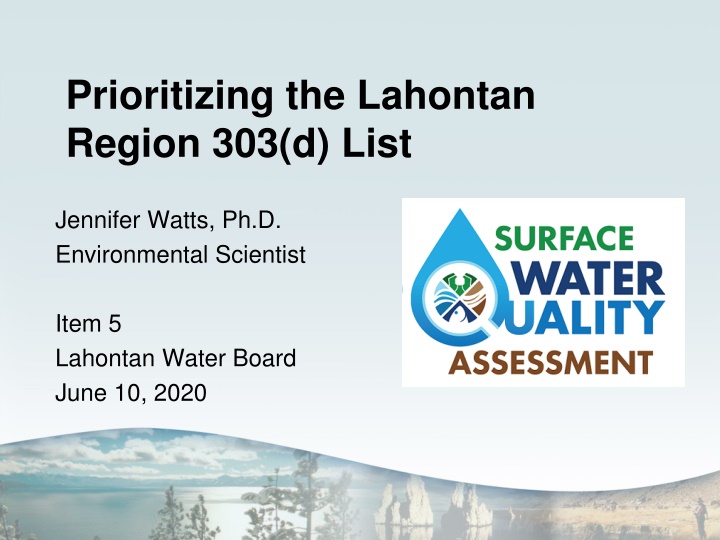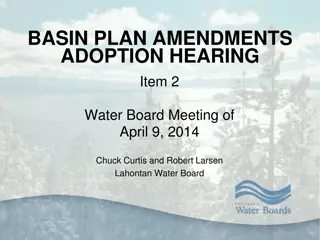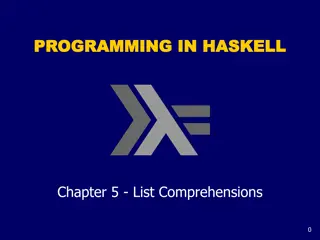Prioritizing the Lahontan Region 303(d) List Overview
This presentation discusses the 303(d) list for the Lahontan region, addressing impairments in surface waters that do not meet water quality objectives. It covers updates, prioritization strategies, and different impairment categories. The presentation also delves into the implications and actions required for addressing various impairments in the region.
Download Presentation

Please find below an Image/Link to download the presentation.
The content on the website is provided AS IS for your information and personal use only. It may not be sold, licensed, or shared on other websites without obtaining consent from the author.If you encounter any issues during the download, it is possible that the publisher has removed the file from their server.
You are allowed to download the files provided on this website for personal or commercial use, subject to the condition that they are used lawfully. All files are the property of their respective owners.
The content on the website is provided AS IS for your information and personal use only. It may not be sold, licensed, or shared on other websites without obtaining consent from the author.
E N D
Presentation Transcript
Prioritizing the Lahontan Region 303(d) List Jennifer Watts, Ph.D. Environmental Scientist Item 5 Lahontan Water Board June 10, 2020
Overview of Presentation Review contents of 303(d) List Updates to the Prioritization Strategy Review Definition of Bins Present Summary of Prioritized Impairments Comments or Questions 2 Agenda Item #5
Lahontan 303(d) List States are required to identify surface waters that do not meet water quality objectives (WQOs) CA waterbody assessments are conducted in accordance with the State Water Board s Water Quality Control Policy for Developing California s CWA Section 303(d) List Waters not attaining WQOs are impaired and are identified in the 303(d) List or List of Impaired Waterbodies Agenda Item #5 3
2018 updates to the 303(d) List 2012 303(d) List: 157 waterbody/pollutant combinations (i.e., individual impairments) 77 Waterbodies impaired 2018 303(d) List: 257 individual impairments 126 Waterbodies impaired 42 waterbodies with no new data this cycle 4 Agenda Item #5
2020 Prioritization Strategy 5 Agenda Item #5
Bin 1 Impairments Impairments addressed by an adopted TMDL or TMDL alternative. Examples include: Lake Tahoe TMDL addresses nutrient and sediment impairments Leviathan Mine CERCLA Clean-up addresses assorted metals impairments in Aspen, Bryant, and Leviathan Creeks 6 Agenda Item #5
Bin 2 Impairments Impairment considered confirmed and requires TMDL or alternative action Assigned to high, medium or low priority tiers High priority for: Human Health effects Impacts on Aquatic Life Potential impacts to disadvantaged communities 7 Agenda Item #5
Bin 3 Impairments Impairments that require additional information Small data sets may not adequately characterize water quality; more data is needed prior to devoting staff resources Listing policy requires only two exceedances to list for toxic pollutants Example: New Susan River Total Nitrogen listed based on three exceedances 8 Agenda Item #5
Bin 4 Impairments Impairment identified for possible basin planning action E.g. revised WQO, site specific objectives, or other non-TMDL basin planning action Example: Mojave River 303(d) listings for sulfate and fluoride Local geology likely contributes to these impairments 9 Agenda Item #5
Summary of Prioritization Results Bin 3 More info Bin 4 Basin Planning Bin 1 Bin 2 Addressed Confirmed Number of Waterbodies 29 27 72 26 Number of Impairments 45 50 116 45 EPA Vision Projects Impairments 23 10 Agenda Item #5
Additional Prioritization Results Bin 1 31 Impairments addressed by 6 adopted TMDLs 14 Impairments addressed by non-TMDL actions Bin 2 11 High Priority Impairments require action Potential Human Health effects Bin 4 Example High Priority Impairments 16 Waterbodies listed for TDS 11 Agenda Item #5
Thank You Questions or comments? Contact info: Jennifer Watts 530 542 5491 Jennifer.watts@waterboards.ca.gov Trout Creek above Lake Tahoe 12 Agenda Item #5























